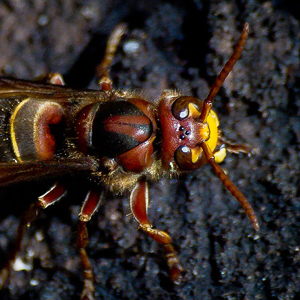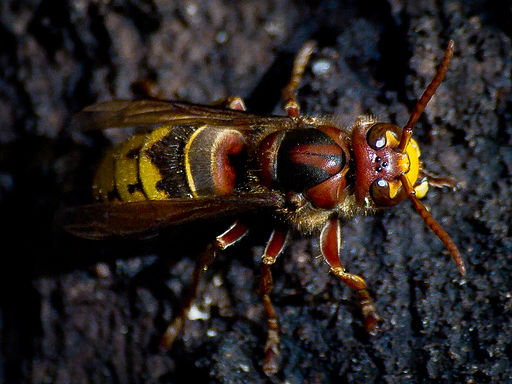Large Wasps That Bang on Your Windows!
By Chris Williams on April 22, 2014.
 Question
Question
We have really big wasps banging into our patio door off of our deck. They’re brown and yellow. I’ve looked outside for a nest but I don’t see anything. Are these giant yellowjackets? Are they trying to get inside? W.H., Bedford, NH
Answer
They’re not really trying to get inside. One of two things is happening. Either they are just bumbling around looking for good nest sites around your home, or they are attracted to lights inside your house and don’t realize there is glass in the way.
Early spring is when mated female wasps that have spent the winter in hiding emerge and look for protected places to build their nests. In the beginning, a single queen starts the nest. She lays her first eggs and once the worker wasps hatch, they take over the nest’s duties while the queen spends all of her energy laying eggs and growing the nest.
Paper wasp queens are very active right now, especially on warm days. They fly low and lazy around porch overhangs and around roof lines, looking for a protected place to attach their paper comb nests onto your house. Paper wasps are dark and skinny with dangling legs. Their nests are uncovered combs that look like upside-down umbrellas (see “Paper Wasps Are Building Their Nests Now”).
Yellowjacket queens and baldfaced hornet queens are also scouting for nest sites, but if your wasps are very large (one inch long), they could be European hornets. Although the wasps themselves are very visible, you usually don’t see a European hornet’s large nest. It doesn’t hang in a tree like the baldfaced hornet’s nest. The nest is usually constructed inside a hollow tree, but can also be found in a wall void, attic, or old bee nest or bird house.
European hornets are unusual in that they fly at night. They also are attracted to lights and will bang into windows with some force. That’s scary for people and seems threatening but, despite their size, these wasps are not as aggressive as yellowjackets.
Why Are European Hornets a Problem?
Even if you can get used to hornets banging into your windows, there are other reasons why European hornets can be a problem around homes: they damage lilac bushes and fruit, and cause damage when they build nests in walls and attics.
Although European hornets are considered beneficial because they feed primarily on insects, they also strip the bark from lilac bushes to feed on the sap and they will suck juices from ripe fruit on trees. Nests that are built inside building voids can have 6 to 9 combs without a papery cover. The nests can be 2-3 feet long and have a noticeable smell.
If you have wasps of any type nesting on or in your home, give Colonial a call. We can locate and remove the nest. Don’t wait too long to call. Wasp nests continue to grow in size and numbers throughout the summer. A mature European hornets’ nest can have 400 wasps. You don’t want that on the other side of your wall!
